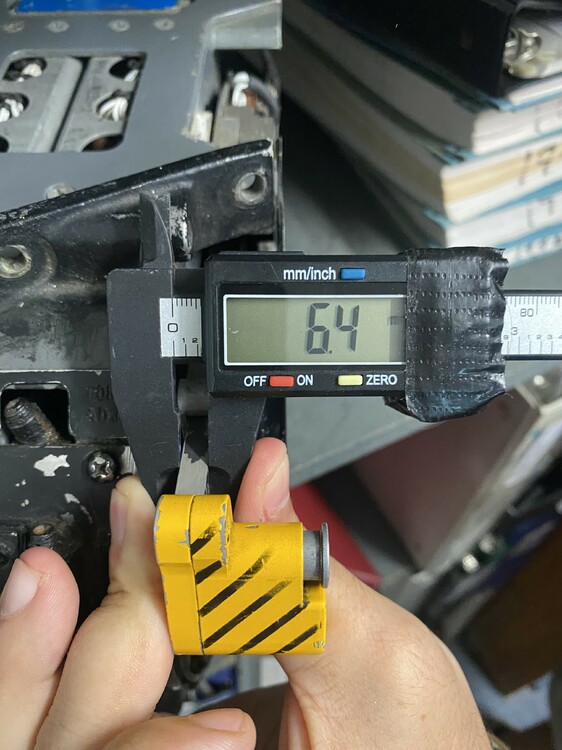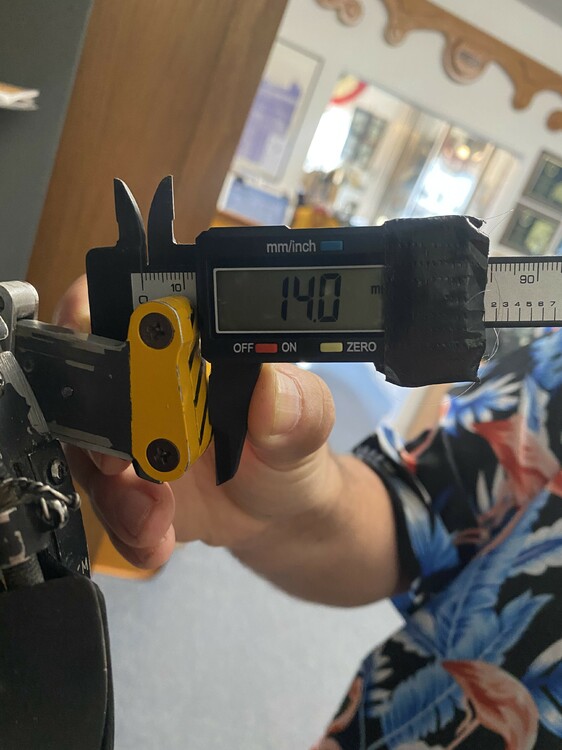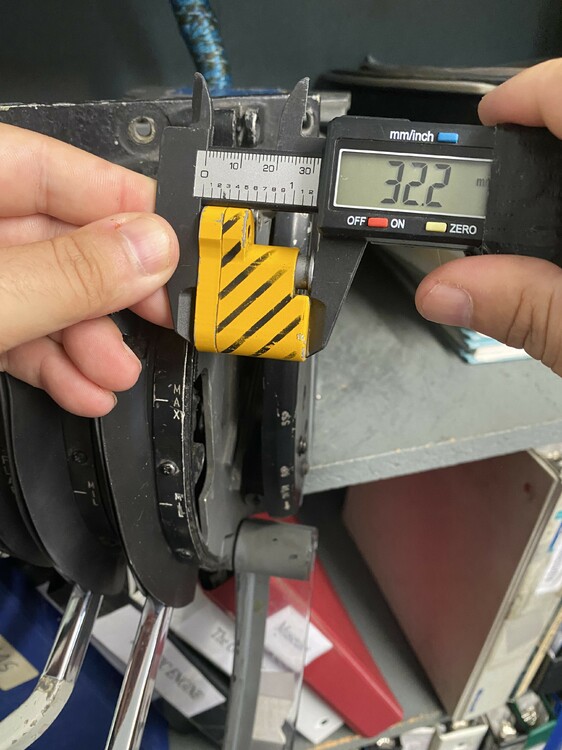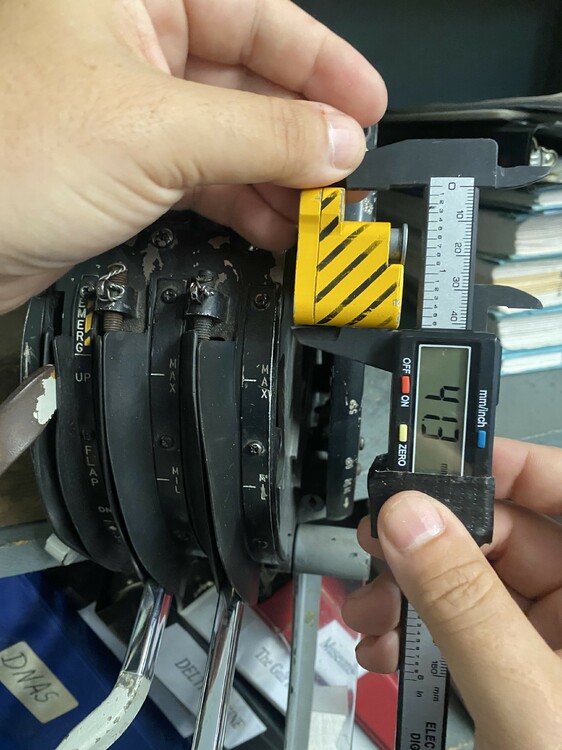

75th ORD EOD Cheesecake
Members-
Posts
9 -
Joined
-
Last visited
Recent Profile Visitors
The recent visitors block is disabled and is not being shown to other users.
-

F-14 Cockpit and instrument dimensions
75th ORD EOD Cheesecake replied to punk's topic in DCS: F-14A & B
@Chronocidal Sorry for the delay in posting these. I was pinged on here in June to help you out with dimensions, but got tied up doing a UXO assessment for the day job which kept me out of the museum over the summer. Here's some reference images for the emergency sweep handle dimensions. I left my caliper in millimeters for ease of international reference. For operation, the handle raises 1.5 inches when pulled to the emergency setting. The steel button must be depressed to drop the handle back into the spider from the emergency settings. Depressing it rotates the locking tab visible in one of the photos to clear the lip of the arm actuator sleeve. After that it sometimes requires some searching back and forth to find the actual detent. Our resident A model driver was telling me that in the early days, this would manifest as watching the wings "flap" in and out a handful of degrees on a tomcat that received it's "spread wings" signal, before the SOP became to pull the FC1 and FC2 breakers near the pilot's left knee and leave them pulled until on the catapult. This meant you could search all day for the detent and the wings would never move until you were ready. The heatblur cockpit model actually has these two breakers highlighted with red circular stickers for the pilot's reference. Also of note is that the emergency sweep handle control is not nearly as precise as the CADC assisted manual control on the throttle, with manual being able to command in 1 degree increments, but emergency in 3 degree increments. Let me know if you have any further measurement needs. Also of note: The museum has given me free reign to rebuild the cockpit once I have the requisite instruments for it. I've started grabbing what authentic ones I can find, so if any of y'all find tomcat parts in the greater internet, please let me know. Obviously ill be fabricating some things that will be impossible to find, like the CRT's for the front and the PTID for the back. We'll be setting up a social media page for the museum over the next couple months, and i will post the relevant links here when that goes online. -

F-14 Cockpit and instrument dimensions
75th ORD EOD Cheesecake replied to punk's topic in DCS: F-14A & B
-

F-14 Cockpit and instrument dimensions
75th ORD EOD Cheesecake replied to punk's topic in DCS: F-14A & B
-

F-14 Cockpit and instrument dimensions
75th ORD EOD Cheesecake replied to punk's topic in DCS: F-14A & B
My dumb a$$ replacing a rigid fluid line on the starboard main gear door. Notice that the F-14 has flat (90 degree) fittings for its rigid fluid lines, as opposed to the far more common (in aviation) flared fittings. “Coincidentally” this is the exact same fluid line design used on the Grumman Lunar Module. -

F-14 Cockpit and instrument dimensions
75th ORD EOD Cheesecake replied to punk's topic in DCS: F-14A & B
Well, to answer the common question, the Navy handles their displays differently than the other branches. Our aircraft and the others like it are still wholly owned by the Navy and they have some weird mandates they want to enforce. The impulse carts and Underseat Rocket Motor Pack (called us-rump) are removed from the seats, the survival kit is emptied, and the TID and RWR displays are pulled. The displays are pulled because the navy considers them sensitive items, and because Iran still has their airframes, they likely won’t ever be returned to us. I’ve always found that a little silly as there are HD LCD screens that are available commercially that can display the same stuff better than original equipment. Most display tomcats never get their Martin bakers reinstalled as certifying the seats as inert is a pain in the backside, and often they will vanish into the night. Luckily we had ours certified inert and they remain where they should be, in the jet. The Navy sealed our canopy in 2008 shortly after an incident where someone had acquired a M61 and was attempting to get the museum to buy it. NCIS got involved, pointed a bunch of guns at the old Vietnam vets that were there and a week later they bolted the canopy shut with a 3x5 inch steel plate. She requires a significant amount of attention and love, as Florida is not kind to her. Embry Riddle has a group of students that spend time keeping her clean and manufacture various items for us. They are currently manufacturing dummy AIM-9Ls for the jet. Next semester they will be starting on AIM-7s. I’ll post some other pictures here shortly. Again, if anyone wants pics of specific things, I am at the museum on saturdays. Here is our aircraft during its service in VF-143 Here she is in her current VF-103 livery. Embry Riddle students cleaning the tennis court. -

F-14 Cockpit and instrument dimensions
75th ORD EOD Cheesecake replied to punk's topic in DCS: F-14A & B
Not sure if any of you need images of the F-14 throttle quadrant, but here is ours. I'm one of the maintainers of F-14 BUNO:161426 at the Deland Naval Air Station Museum. I can provide pictures of our aircraft as needed and upon request. Unfortunately our canopy has been sealed by the Navy, so our throttle quadrant is the only cockpit item I can provide pictures of without looking through the canopy. I'm at the museum most every saturday. -
VT stands for Variable Time, which is a fancy way to say proximity fused. For most MK80 series this means you would see a plastic dome TDD on the nose with an electronic fuse in the tail. There is a different color TDD for the MK82, 83, and mk84. Theyu look like colored gumdrops stuck on the nose of the bomb. The options were green white and red, but for the life of me i cant remember which went with which. Pain in the ass to walk up on for defusal when they dont go off. You would generally only see VT fuses used for the mk80 series or for almost any dispenser, as most of the precision guided munitions have electronic fuses in the tail that sense impact or negative-space after impact. ***addendum*** I almost forgot about the DSU-33 which was a joint Airforce/Navy venture to replace the TDD's, which were Navy exclusive. They perform identical functions for the MK80 series
-
MFDH (maximum fragmentation distance horizontal) for the MK83 series is approximately 2520 feet. Are all those tiny bits of frag going to travel that far? Of course not. The strongback (the portion of the bomb where the lifting lugs and charging well are located) and the baseplate (the potion of the bomb where the fin kit is installed) generally remain intact upon detonation as the metal in those areas is much thicker than the rest of the bomb body. These two parts retain a great deal of kinetic energy upon detonation and fly farthest. Smaller bits of frag usually only travel about 50-75 percent of the MFDH. All explosive calculations for specific ordnance are based on the MFDH and K-Factor worst case scenarios as determined by explosive testing at EOD TechDiv, or from recorded incidents. The real interesting question is whether the aircraft system is plotting the frag envelope as a fixed altitude over its current position, or as a calculation of altitude at the projected point of impact.
-

Bomb Strength Mods
75th ORD EOD Cheesecake replied to dresoccer4's topic in Utility/Program Mods for DCS World
As someone who regularly works with explosives and has intimate familiarity on how to either maximize or minimize explosive hazards presented by military ordnance, i wondered this too. You're talking about the MK83 1000lb warhead which is made of typical ordnance grade steel and uses about 450 lbs of Tritonal 80/20 as a filler. Your primary hazards on the MK81-MK84 are blast overpressure and fragmentation from the bomb case with the largest (and furthest flying) pieces being the baseplate, strongback, and lifting lugs. Overpressure is important for the sim because the soft squishy humans cant hide from it. You might miss the vehicle but the driver and passengers would have a nasty TBI. Fragmentation pokes holes in humans or objects and the like, but like any projectile, its mostly line of sight. Keeping this in mind, the two measurements used in explosive safety work are K-Factors and MFDH (maximum fragmentation distance horizontal). For your mk 83 warhead your MFDH is approximately 300.74YDS (275Meters) with an initial estimated fragment speed of about 18,000 ft/sec. Without getting into the heavy math your K-factors for the same warhead are: K-328 (recommended evac distance for non-essential personnel) = 921.92 YDS (843M) K-50 (recommended evac for essential personnel) = 141.08 YDS (129M) K-24 (Absolute minimum evac distance for essential personnel) = 67.8 YDS (62M) Remember, you can hide from frag, but not from blast. I wouldn't want to be near that minimum if i didn't absolutely need to be.) Anything closer than 65 YDS is pretty much guaranteed injury up to and including death the closer you get. Understand that these pressure values are baseline with the assumption that the individual has both frontal and overhead cover from the blast. Based on my experience, aircraft and light skinned vehicles on the ground would be susceptible to damage of some sort at about 0-120 yds from a MK83. Understand that im just a simple EOD Tech so im basing that range on my pretty basic understanding of aircraft construction, and extensive experience blowing sh!t up.























.thumb.jpeg.c0269cdf3ff1435b023bd0a7c268c2fa.jpeg)